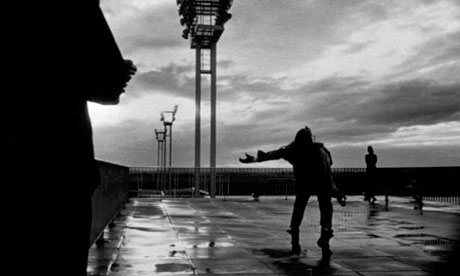I watched Dark Shadows recently. Not a great movie in general, but when Tim Burton makes such visual beauty, why quibble over such inconsequential details like a lame script and stilted dialogue? The fantastic thing about Dark Shadows‘ look, especially within the larger Burton milieu, is how he juxtaposed that kind of spectral Victoriana he does so well with an almost camp take on late 60s/early 70s nostalgia. And the soundtrack is pretty ace, too.
The whole “vampire confounded by modern world” were the liveliest bits of the movie, but my favorite-looking parts was definitely the supernatural-y, ghostly stuff: haunted mansions, Gothic cliffs, a spirit or two knocking around. It falls into what I call the “pretty ghost aesthetic”: Victorian-influenced, pale fire etherealness, flowing hair, alabaster skin, wide eyes, beautiful lace and pearl-encrusted dresses — and of course, you’re so graceful because you float everywhere. (Floating gracefully is very important as a pretty ghost.)
Pretty ghosts are like the other side of fashion-Goth: instead of all-black, it’s milky-white, pure and wraithlike. It’s the other side of death, made beautiful, plaintive and graceful, the kind of look that classical ladies themselves once cultivated with their pale arsenic-laced complexions and their dark, haunted eyes — aided with the help of some belladonna, of course. (Nothing like a little poison to dilate the pupils.)
Pretty ghosts are all over Burton’s movies, and I think Dark Shadows had the prettiest ghost of all, ever, with these delicious little bits of Bella Heathcote floating along, heading into the magic wind machine of eternity:
But you don’t have to be a real ghost to be part of the pretty ghost aesthetic in a Tim Burton movie. Burton’s take on “Alice in Wonderland” turned Anne Hathaway into a visual pretty ghost: pale skin, white dress, flowing hair, check, check and check. Even real-life brunettes can be pretty ghosts, if their skin is pale enough!
Burton did the same thing, after all, to Christina Ricci for Sleepy Hollow, which I really actually want to revisit as a movie. I remember her wardrobe in the film being particularly gorgeous:
Sadly, as an Asian lady with medium-dark olive skin, it’s hard for me to be able to participate in the pretty ghost look, even with the help of Oscar-winning costume designers and makeup artists. And in all honesty, I feel uncomfortable in costume-like clothing, and tend to privilege feeling natural and at ease in my daily life when it comes to fashion. I might just be a pretty ghost for Halloween, but in real life I’m just me.
But I love a nice Victorian detail when it comes to a lovely blouse, so my yen for pretty ghosts does come out in little ways. This summer I got a cream lace t-shirt this past summer that is makes me think of pretty-ghost Victorian, but I wear it with jeans and so it feels more 70s singer-songwriter than Henry James ghost story heroine. (His “Turn of the Screw” is one of my favorite ghost stories ever.)
I did get a lovely headband that does make me feel a little pretty and floaty. I’ll just pretend it’s Rowena Ravenclaw’s diadem or something. Or part of my snow princess raiment.
Isn’t it lovely and sparkly? It’s about as close to pretty ghost as I can get.


